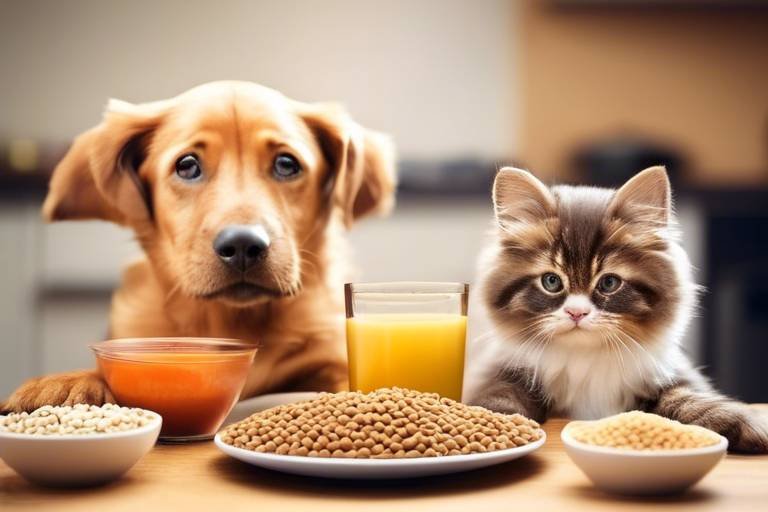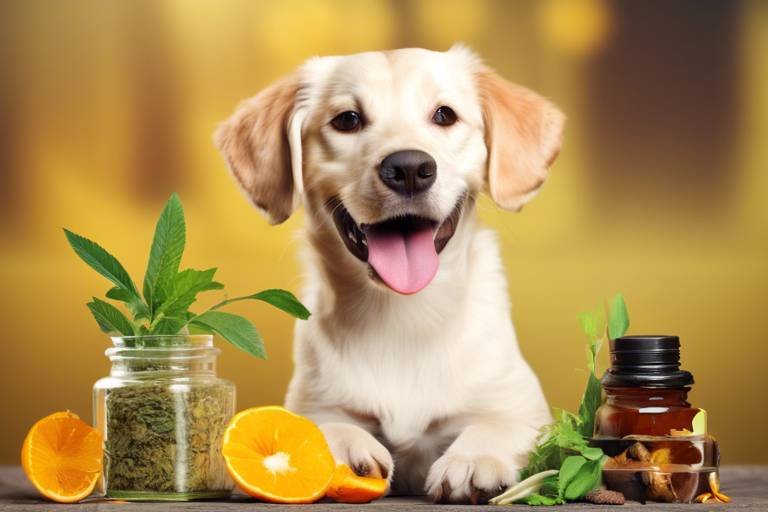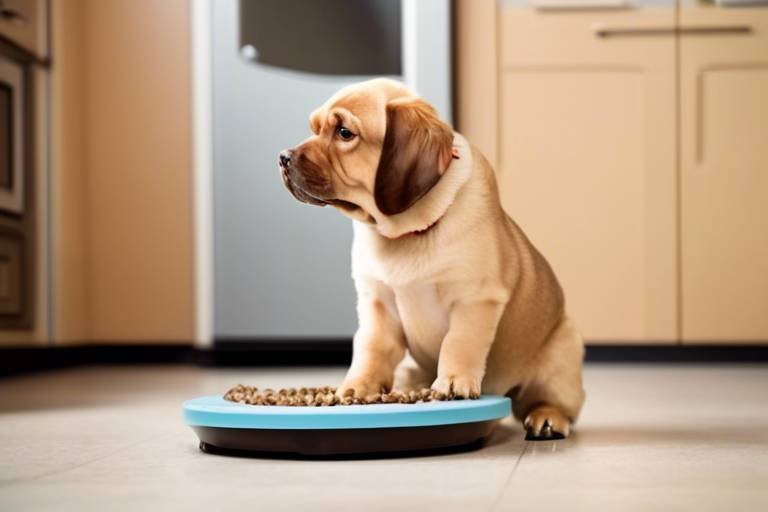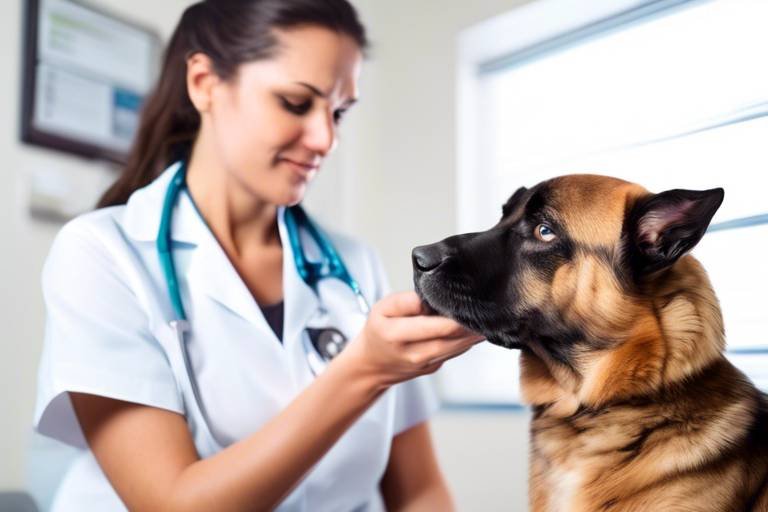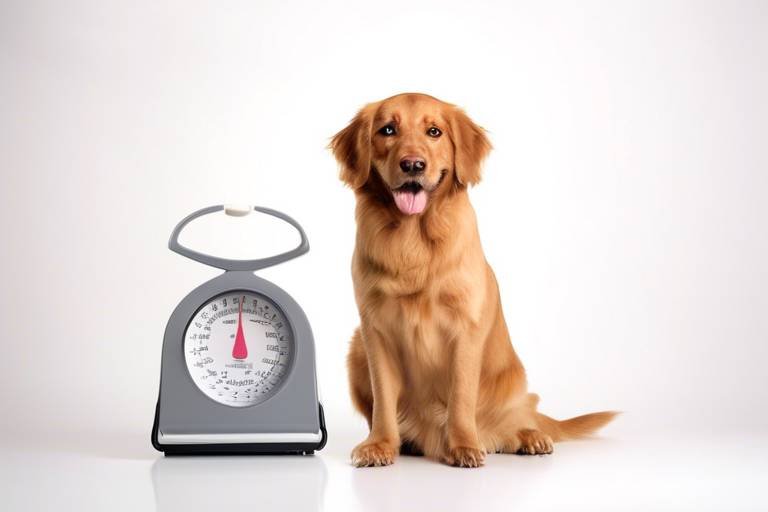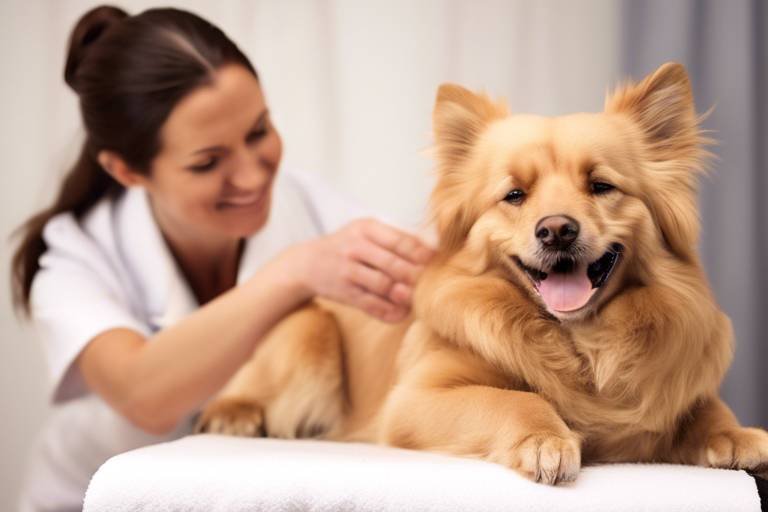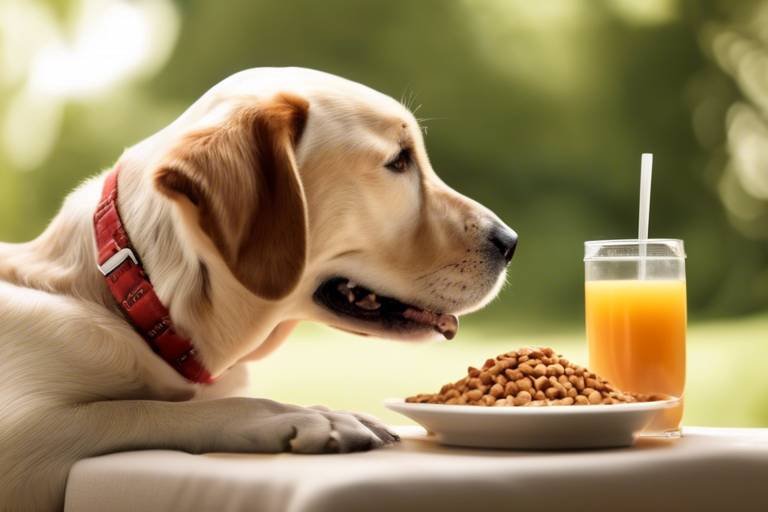How to Choose Safe and Healthy Pet Foods
Choosing the right food for your beloved pet can feel like trying to navigate a maze blindfolded. With so many options on the market, how do you ensure that what you're feeding your furry friend is not only safe but also nutritious? This article covers essential tips and guidelines for selecting safe and nutritious food for your pets, ensuring their well-being and health through informed choices. After all, a healthy pet is a happy pet, and it starts with what’s in their bowl!
Just like humans, pets have unique nutritional requirements that vary based on their species, age, and health status. For instance, a growing puppy has different needs compared to a senior dog. Cats, on the other hand, are obligate carnivores, meaning they require a diet rich in animal protein. Understanding these basic nutritional needs is crucial for making informed food choices. It’s not just about filling their bowl; it’s about fueling their bodies with the right nutrients.
Once you’ve grasped your pet’s nutritional needs, the next step is learning how to read and interpret pet food labels. This skill is essential for selecting high-quality products. Pet food labels can be a treasure trove of information, but they can also be confusing. Key components to look for include the guaranteed analysis, ingredient list, and feeding guidelines. Understanding these elements will empower you to make better choices for your pet’s diet.
Identifying beneficial ingredients is essential for ensuring your pet's diet is nutritious. When scanning labels, here are some top ingredients you should seek:
- High-Quality Proteins: Look for named meat sources like chicken, beef, or fish as the first ingredient.
- Whole Grains: Ingredients like brown rice or oats provide necessary fiber and energy.
- Fruits and Vegetables: Ingredients such as blueberries, carrots, and spinach offer essential vitamins and antioxidants.
Proteins are vital for pet health, serving as the building blocks for muscles, skin, and fur. High-quality protein sources are crucial for your pet's overall well-being. When selecting pet food, ensure that it contains real meat as the primary ingredient. This not only supports muscle development but also aids in recovery and energy levels. Think of protein as the fuel that keeps your pet's engine running smoothly!
Vitamins and minerals play a critical role in your pet's health. They support immune function, bone health, and overall vitality. Essential nutrients like calcium, phosphorus, and vitamins A, D, and E should be included in their diet. Just like a well-balanced diet for humans, your pet needs a mix of these nutrients to thrive. Always check the label for a complete vitamin and mineral profile to ensure your pet is getting everything they need.
Not all ingredients are beneficial for pets. It's equally important to know what to avoid. Harmful additives and fillers can negatively impact your pet's health. Ingredients like artificial colors, flavors, and preservatives should raise red flags. Additionally, steer clear of unnamed meat by-products and excessive fillers like corn and soy. These can lead to allergies and other health issues. Remember, if you wouldn’t eat it, why should your pet?
Deciding between dry and wet pet food can significantly affect your pet's health and hydration. Each type has its pros and cons. Dry food is generally more convenient and can help maintain dental health due to its crunchy texture. On the other hand, wet food can enhance hydration and is often more palatable for picky eaters. It’s essential to weigh these factors based on your pet’s individual needs and preferences.
Dry food is often lauded for its convenience and shelf stability. It can help maintain dental health by reducing plaque buildup. Plus, it’s easy to measure and store, making it a popular choice among pet owners. However, it’s crucial to choose a high-quality brand that uses real ingredients to ensure your pet is getting the nutrition they need.
Wet food can be a game-changer, especially for pets that struggle with hydration. Its higher moisture content can help keep your pet hydrated, which is particularly beneficial for cats. Additionally, wet food is often more flavorful and can entice picky eaters. If your pet seems uninterested in dry kibble, consider incorporating wet food into their diet for a tasty boost!
Consulting with a veterinarian is crucial when determining the best diet for your pet. They can provide valuable insights tailored to your pet's specific health needs, age, and activity level. Don’t hesitate to reach out to your vet—they're your best resource for ensuring your pet’s dietary requirements are met.
Switching your pet's food requires a gradual transition to avoid digestive issues. Abrupt changes can lead to upset stomachs and other gastrointestinal problems. To safely introduce new food to your pet's diet, follow a gradual approach over several days.
To minimize gastrointestinal upset, consider the following steps:
- Start by mixing a small amount of the new food with the old food.
- Gradually increase the proportion of new food over 7-10 days.
- Monitor your pet's response and adjust as necessary.
It's essential to observe your pet's reaction to new food. Watch for any signs of allergies or digestive upset, such as vomiting or diarrhea. If you notice any adverse reactions, consult your veterinarian immediately. Adjusting the diet based on your pet's health and preferences is key to ensuring their happiness and well-being.
Q: How often should I feed my pet?
A: Feeding frequency varies by species and age. Generally, adult dogs can be fed once or twice a day, while puppies and kittens may require more frequent meals.
Q: Is grain-free food better for my pet?
A: Grain-free diets are not necessarily better for all pets. Consult with your veterinarian to determine if a grain-free diet is suitable for your pet's specific needs.
Q: Can I mix wet and dry food?
A: Yes! Mixing wet and dry food can provide a balanced diet and enhance palatability. Just ensure the total daily intake aligns with your pet's nutritional needs.
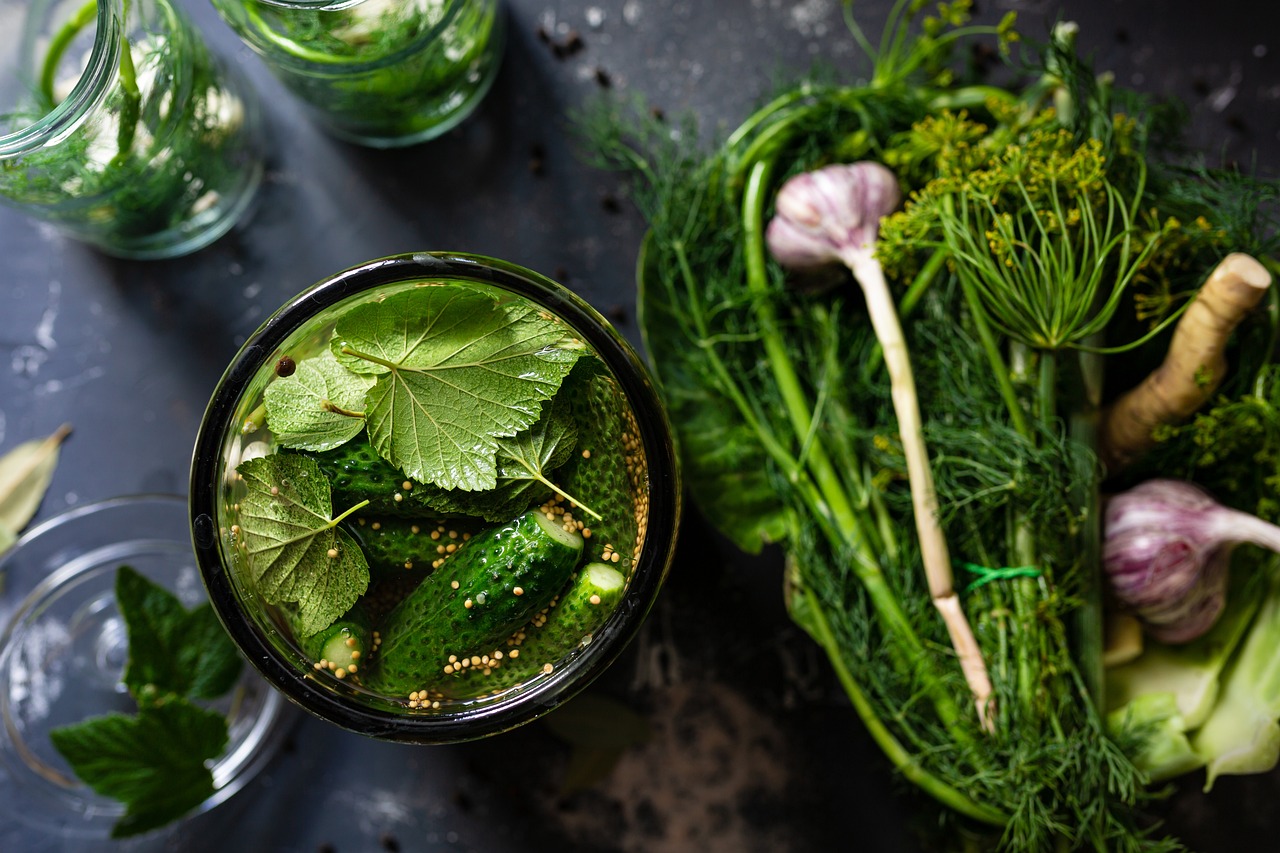
Understanding Pet Nutritional Needs
When it comes to our furry friends, understanding their nutritional needs is crucial for their overall health and happiness. Just like humans, pets require a balanced diet that caters to their unique needs based on factors such as species, age, activity level, and health status. For instance, a growing puppy has different dietary requirements compared to a senior dog. Similarly, a high-energy cat may need more protein than a laid-back feline. This is why it's essential to tailor their diet to meet these specific needs.
Let’s break it down a bit further. Pets need a mix of proteins, fats, carbohydrates, vitamins, and minerals. Each of these components plays a vital role:
- Proteins: These are the building blocks of your pet's body, essential for growth, repair, and overall health. They help in building muscle and maintaining a healthy immune system.
- Fats: Healthy fats provide energy and support cell structure. They also help in the absorption of certain vitamins.
- Carbohydrates: While not always essential, carbs can provide a quick source of energy and aid in digestion.
- Vitamins and Minerals: These are necessary for various bodily functions, including bone health, immune function, and metabolic processes.
Moreover, pets have specific dietary needs based on their species. Dogs are omnivores, meaning they can thrive on a combination of meat and plant-based foods, while cats are obligate carnivores, requiring a diet primarily consisting of meat. This fundamental difference highlights the importance of choosing the right food. In fact, some pet owners might find themselves overwhelmed by the plethora of options available in stores. But don't worry; understanding your pet's unique needs can simplify the process.
It’s also worth noting that age plays a significant role in determining what your pet should eat. Puppies and kittens require nutrient-dense foods to support their rapid growth, while senior pets may benefit from diets that are lower in calories but higher in fiber to maintain a healthy weight and digestive health. Consulting with a veterinarian can provide personalized insights into your pet’s specific needs, ensuring that the food you choose is not just safe but also nutritious.
In summary, understanding your pet's nutritional needs is not just about picking up any bag of pet food off the shelf. It involves a thoughtful approach that considers their species, age, activity level, and health conditions. By focusing on these factors, you can make informed choices that will lead to a happier, healthier life for your beloved companion.
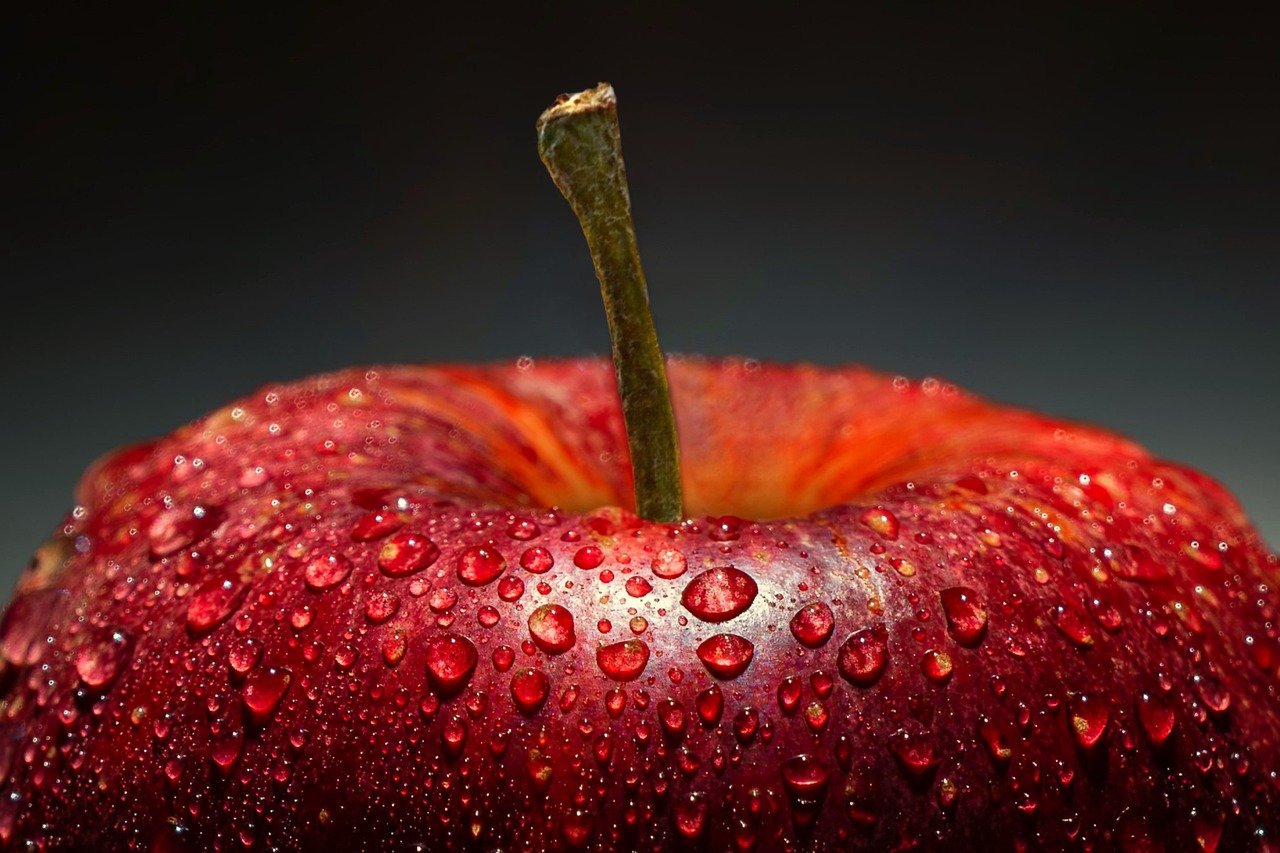
Reading Pet Food Labels
When it comes to selecting the right food for your beloved pet, understanding how to read pet food labels is absolutely crucial. Think of pet food labels as a roadmap, guiding you toward making informed decisions about what goes into your furry friend's bowl. These labels can be packed with information, and at first glance, they may seem overwhelming. However, once you get the hang of it, you'll be able to navigate them like a pro, ensuring that your pet gets the best nutrition possible.
The first thing to look for is the ingredient list. Ingredients are typically listed in descending order by weight, so the first few items will make up the bulk of the product. If you see a high-quality protein source, such as chicken or beef, listed first, that's a great sign. On the other hand, if you notice vague terms like "meat by-products" or "animal digest," it might be a red flag. You want to ensure that your pet is getting real, identifiable ingredients rather than mysterious fillers.
Next, pay attention to the Guaranteed Analysis section, which provides important nutritional information, including the minimum percentages of crude protein and fat, as well as the maximum percentages of fiber and moisture. This allows you to compare the nutritional content of different brands and types of food. For example, if you're looking for a high-protein diet for your active dog, aim for a product that lists at least 20% crude protein on the label.
Another key component to consider is the AAFCO Statement. The Association of American Feed Control Officials (AAFCO) sets standards for pet food labeling. Look for a statement that indicates the food meets AAFCO's nutritional standards for your pet's specific life stage, whether it's growth, maintenance, or all life stages. This ensures that the food has been formulated to provide complete and balanced nutrition.
It's also wise to be cautious of marketing claims. Terms like "natural," "holistic," or "premium" are often used to entice buyers, but they can be misleading. Always check the ingredient list and nutritional information to see if the product lives up to these claims. Remember, a fancy label doesn't necessarily mean it's the best choice for your pet.
Lastly, consider the expiration date. Just like human food, pet food can spoil. A fresh product is essential for your pet's health, so always check the packaging for a "best by" date to ensure you're feeding them the safest and most nutritious food possible.
In summary, reading pet food labels is an essential skill for any pet owner. By focusing on the ingredient list, guaranteed analysis, AAFCO statement, marketing claims, and expiration date, you can make informed choices that will keep your pet healthy and happy. Remember, your pet's diet is one of the most significant factors in their overall well-being, so take the time to become familiar with what’s in their food.
- How can I tell if a pet food is high quality? Look for recognizable ingredients, high protein content, and an AAFCO statement indicating it meets nutritional standards.
- What are by-products in pet food? By-products are secondary products derived from the processing of meat and can vary in quality. It's best to choose foods with specific protein sources listed.
- Is wet food better than dry food? It depends on your pet's needs. Wet food can provide extra hydration, while dry food can help with dental health.
- How often should I check pet food labels? Always check labels when purchasing new food and periodically review your pet’s diet to ensure it remains suitable for their changing needs.
Ingredients to Look For
When it comes to choosing the right pet food, knowing which ingredients to look for can make all the difference in ensuring your furry friend gets the nutrition they need. Just like humans, pets require a balanced diet filled with essential nutrients to thrive. So, what should you be on the lookout for when perusing those pet food aisles? Well, let’s break it down!
First and foremost, high-quality proteins should be at the top of your list. Proteins are the building blocks of life; they help in the growth and repair of tissues and are crucial for maintaining a healthy immune system. Look for specific protein sources like chicken, beef, or fish listed as the first ingredient. This indicates that the food is rich in the necessary amino acids that your pet needs. Avoid generic terms like "meat meal" or "by-products," as they can be vague and may not provide the quality you want.
Next up, essential fatty acids are another important ingredient to consider. These healthy fats, such as Omega-3 and Omega-6, play a vital role in maintaining skin and coat health, as well as supporting brain function. You can often find these listed as fish oil or flaxseed oil in the ingredient list. Remember, a shiny coat is not just for looks; it’s a sign that your pet is receiving the right nutrients!
Don’t forget about vitamins and minerals. These micronutrients support various bodily functions and help keep your pet in tip-top shape. Look for foods that include a range of vitamins like A, D, E, and K, as well as minerals such as calcium and phosphorus. These nutrients are essential for bone health, vision, and overall vitality. Many premium pet foods will include these in their formulations, so keep an eye out!
Another beneficial ingredient is whole grains. Ingredients like brown rice, oatmeal, and barley can provide your pet with a good source of energy and fiber. They help in digestion and can keep your pet feeling full longer. However, be cautious with grain-free diets unless your pet has specific allergies, as grains can be a healthy part of their diet.
Finally, consider the inclusion of probiotics. These live bacteria support gut health and can help with digestion. Some pet foods even add prebiotics, which are types of fiber that feed the good bacteria in your pet's gut. This combination can lead to a healthier digestive system and overall better health.
In summary, when you're choosing pet food, keep an eye out for:
- High-quality proteins (like chicken, beef, or fish)
- Essential fatty acids (like Omega-3 and Omega-6)
- Vitamins and minerals (like A, D, E, calcium, and phosphorus)
- Whole grains (like brown rice and barley)
- Probiotics and prebiotics for digestive health
By focusing on these ingredients, you can ensure that you're providing your pet with a diet that supports their overall health and well-being. After all, a well-nourished pet is a happy pet!
Q: How can I tell if my pet food is high-quality?
A: Look for specific, identifiable ingredients, especially high-quality protein sources, and ensure that the food meets the AAFCO (Association of American Feed Control Officials) standards.
Q: Is it necessary to choose grain-free food for my pet?
A: Not necessarily. Many pets thrive on diets that include grains, unless they have specific allergies or sensitivities. Always consult your veterinarian for personalized advice.
Q: How do I know if my pet is getting enough nutrients?
A: A balanced diet that includes a variety of ingredients, along with regular vet check-ups, can help ensure your pet is getting the nutrients they need. Look for signs of good health, such as a shiny coat, healthy weight, and active behavior.
High-Quality Proteins
When it comes to your pet's diet, are absolutely essential. Think of proteins as the building blocks of life; they play a crucial role in maintaining your pet's overall health, supporting everything from muscle development to immune function. Just like we need a balanced diet to thrive, our furry friends require the same care when it comes to their food. So, how can you ensure that your pet is getting the right kind of protein?
First off, it's important to recognize that not all proteins are created equal. High-quality proteins come from identifiable sources, such as real meat, fish, or poultry. When you're browsing through pet food options, look for ingredients like chicken, beef, or salmon listed at the top of the ingredient list. This indicates that these protein sources are present in significant amounts, providing the nutrients your pet needs to flourish. In contrast, ingredients like "meat by-products" or "animal meal" can be vague and often indicate lower-quality protein sources. It's like choosing between a gourmet steak and mystery meat—one is clearly better for you!
Moreover, proteins aren't just about quantity; they also need to be of high quality. High-quality proteins are easily digestible and provide a complete amino acid profile, which is vital for your pet's health. Amino acids are the building blocks of proteins, and some of them are essential, meaning your pet's body cannot produce them on its own. Therefore, a diet rich in high-quality protein helps ensure that your pet receives all the necessary amino acids for optimal health.
To give you a clearer picture, here's a quick comparison of protein sources:
| Protein Source | Quality Rating | Benefits |
|---|---|---|
| Chicken | High | Rich in essential amino acids; supports muscle growth. |
| Beef | High | Excellent source of iron and zinc; boosts energy levels. |
| Fish (like Salmon) | High | Contains omega-3 fatty acids; promotes healthy skin and coat. |
| Meat By-Products | Low | Vague source; often low in nutritional value. |
Additionally, some pets may have specific dietary needs, such as allergies or sensitivities. In these cases, it may be beneficial to consult with a veterinarian to determine the best protein sources for your pet. For example, if your dog is allergic to chicken, a protein source like lamb or venison might be a better option. It's all about finding the right fit for your pet's unique nutritional requirements.
In summary, selecting high-quality proteins is a fundamental aspect of your pet's diet. By prioritizing identifiable, high-quality protein sources, you're not just filling their bowls—you're investing in their health and happiness. Remember, a well-fed pet is a happy pet, and that happiness often starts with the right protein on their plate!
Essential Vitamins and Minerals
When it comes to our furry friends, just like us, vitamins and minerals play an essential role in maintaining their overall health. These nutrients are crucial for various bodily functions, and understanding their importance can help you make informed choices about your pet's diet. Think of vitamins and minerals as the unsung heroes of pet nutrition; they work behind the scenes to ensure your pet thrives.
First off, let’s dive into the world of vitamins. These organic compounds are vital for your pet's immunity, skin health, and energy levels. For instance, vitamin A is crucial for vision and skin health, while the B vitamins are essential for energy metabolism. Additionally, vitamin D helps regulate calcium and phosphorus, promoting strong bones. If your pet is lacking in these areas, you might notice signs like lethargy, poor coat condition, or even dental issues. That's why choosing a pet food that contains adequate amounts of these vitamins is so important!
Now, let’s not forget about minerals. These inorganic elements are just as significant as vitamins. Key minerals like calcium and phosphorus are essential for bone development and maintenance. Meanwhile, magnesium and potassium support muscle function and nerve transmission. If you were to imagine your pet's body as a well-oiled machine, minerals would be the gears that keep everything running smoothly. A deficiency in minerals can lead to severe health issues, including bone disorders and muscle weakness.
To give you a clearer picture, here’s a quick overview of some essential vitamins and minerals your pet needs:
| Nutrient | Function | Sources |
|---|---|---|
| Vitamin A | Supports vision and skin health | Liver, fish, carrots |
| B Vitamins | Energy metabolism and red blood cell production | Meat, eggs, whole grains |
| Vitamin D | Regulates calcium and phosphorus | Fish liver oil, egg yolk |
| Calcium | Bone development and maintenance | Dairy products, leafy greens |
| Magnesium | Muscle function and nerve transmission | Green vegetables, nuts |
When selecting a pet food, it's crucial to look for brands that explicitly mention these vitamins and minerals in their ingredient list. High-quality pet foods often include natural sources of these nutrients, ensuring your pet receives the best possible diet. Remember, a well-balanced diet filled with essential vitamins and minerals is like a solid foundation for a house; without it, everything else can come crumbling down.
In conclusion, by paying attention to the vitamins and minerals in your pet's food, you're taking a significant step towards ensuring their long-term health and happiness. So, the next time you're shopping for pet food, take a moment to scrutinize those labels. Your pet deserves nothing less than the best!
1. How do I know if my pet is getting enough vitamins and minerals?
Monitoring your pet's health and behavior can provide clues. Signs of deficiency may include lethargy, poor coat condition, and dental issues. Regular vet check-ups can also help assess their nutritional needs.
2. Can pets get all the vitamins and minerals they need from dry food?
Yes, many high-quality dry pet foods are formulated to provide complete nutrition, including essential vitamins and minerals. However, it’s always wise to check the labels and consult with your veterinarian.
3. Are supplements necessary for my pet?
Supplements may be necessary if your pet has specific health issues or dietary restrictions. Always consult your veterinarian before adding any supplements to your pet's diet.
Ingredients to Avoid
When it comes to choosing the right food for your furry friends, it's not just about what should be included in their diet, but also about what should not be. Just like we need to steer clear of junk food to maintain our health, our pets require the same careful consideration. There are several ingredients that can be harmful or simply not beneficial for your pets, and being aware of these can make a significant difference in their overall well-being.
First and foremost, you should be cautious of artificial preservatives such as BHA, BHT, and ethoxyquin. These chemicals are often used to extend the shelf life of pet foods, but they can pose health risks over time. Instead, look for natural preservatives like tocopherols (vitamin E) and ascorbic acid (vitamin C), which are safer alternatives.
Another category to watch out for is fillers. Ingredients like corn, wheat, and soy are commonly used as cheap fillers in pet food. Not only do they provide little nutritional value, but they can also lead to allergies and digestive issues in some pets. If you see these ingredients listed as the first few components, it might be a red flag. Instead, aim for foods that list high-quality proteins and whole grains as primary ingredients.
Additionally, be wary of meat by-products. While they may sound healthy, these by-products can include parts of the animal that are not fit for human consumption, such as organs or even feathers. Look for specific meat sources like chicken, beef, or lamb instead, which indicate a higher quality product.
Lastly, some pet foods contain artificial colors and flavors. These additives are used for aesthetic purposes and to make the food more appealing to pet owners, but they serve no nutritional benefit to your pets. In fact, they can lead to health issues, including allergies and hyperactivity. Always opt for foods that use natural ingredients for flavor and color.
To summarize, here's a quick reference table of ingredients to avoid:
| Ingredient | Why to Avoid |
|---|---|
| Artificial Preservatives (BHA, BHT, Ethoxyquin) | Potential health risks over time |
| Fillers (Corn, Wheat, Soy) | Little nutritional value, can cause allergies |
| Meat By-Products | Includes parts not suitable for human consumption |
| Artificial Colors and Flavors | No nutritional benefit, potential health issues |
By keeping an eye out for these ingredients, you can help ensure that your pet's diet is not only safe but also healthy. Remember, your pet relies on you to make the best choices for their health, so take the time to read those labels carefully!
- What should I look for in a high-quality pet food? Look for specific meat sources, whole grains, and natural preservatives.
- Are all fillers bad for pets? Yes, fillers like corn, wheat, and soy provide little nutritional value and can cause allergies.
- How can I tell if a pet food is safe? Always read the ingredient list and avoid artificial additives and low-quality ingredients.
- Should I consult my veterinarian about pet food? Absolutely! Your vet can provide personalized recommendations based on your pet's health needs.

Choosing Between Dry and Wet Food
When it comes to feeding your furry friends, one of the most significant decisions you'll face is whether to choose dry food or wet food. Each option has its unique set of benefits and drawbacks, and understanding these can help you make the best choice for your pet's health and happiness. Imagine standing in the pet food aisle, surrounded by colorful bags and cans, each promising to be the best. It's like being a kid in a candy store, but instead of sweets, you're choosing the fuel for your beloved companion's body.
First, let's talk about dry food. This option is often more convenient for pet owners. It has a longer shelf life, is easier to store, and can be left out for your pet to nibble on throughout the day. Plus, many dry foods are designed to help maintain your pet's dental health. The crunchiness of the kibble can help reduce plaque and tartar buildup, which is a bonus for many pet parents. However, it's essential to choose a high-quality dry food that contains the right balance of nutrients. Not all dry foods are created equal, so be sure to check the ingredients list.
On the flip side, we have wet food. This option is often more palatable for pets, especially those who might be picky eaters. The moisture content in wet food can also be beneficial for pets that struggle with hydration, particularly cats. If your feline friend seems to prefer a particular flavor or texture, wet food might just be the way to go. However, wet food can be more expensive, and once opened, it typically needs to be refrigerated and consumed within a few days. Additionally, it doesn't provide the same dental benefits as dry food.
So, how do you decide? Here are a few factors to consider:
- Hydration needs: If your pet doesn’t drink enough water, wet food can help keep them hydrated.
- Weight management: Dry food can be easier to measure and control portions, which is helpful for pets that need to lose weight.
- Dental health: If dental issues are a concern, incorporating dry food might be beneficial.
- Cost and convenience: Consider your budget and how much time you can devote to feeding your pet.
Ultimately, many pet owners find that a combination of both dry and wet food works best for their pets. This hybrid approach can provide the benefits of both worlds, ensuring your pet gets the necessary nutrients while also enjoying a variety of textures and flavors. Remember, every pet is unique, and what works for one may not work for another. It's crucial to pay attention to your pet's preferences and health needs.
In summary, whether you choose dry food, wet food, or a mix of both, the key is to ensure that the food is high-quality and meets your pet's specific nutritional needs. After all, a happy pet is a healthy pet!
Q: Can I mix dry and wet food?
A: Yes, many pet owners mix both types of food to provide variety and balanced nutrition.
Q: How do I know which food is best for my pet?
A: Consult your veterinarian for personalized recommendations based on your pet's age, health, and dietary needs.
Q: Is wet food better for older pets?
A: Wet food can be beneficial for older pets, especially if they have dental issues or need extra hydration.
Benefits of Dry Food
When it comes to choosing the right diet for your furry friend, dry food often emerges as a popular choice among pet owners. One of the primary benefits of dry food is its convenience. Imagine being able to scoop out the right amount of food, pour it into your pet's bowl, and be done in a matter of seconds! This ease of use makes dry food a go-to option for busy pet parents who want to ensure their pets are well-fed without spending too much time on meal prep.
Another significant advantage of dry food is its ability to promote dental health. The crunchy texture of kibble can help reduce plaque and tartar buildup on your pet's teeth, acting like a natural toothbrush during mealtime. This can lead to fresher breath and a reduced risk of dental issues, which is a win-win for both you and your pet!
Furthermore, dry food typically has a longer shelf life compared to wet food. Once opened, a bag of dry kibble can last for weeks or even months without spoiling, provided it’s stored properly. This means you can buy in bulk, saving both time and money. Plus, you won't have to worry about the food going bad before your pet finishes it, which can be a concern with wet food.
In terms of nutritional balance, many high-quality dry foods are formulated to meet the complete dietary needs of pets. They often contain a balanced mix of proteins, fats, carbohydrates, vitamins, and minerals, all in one convenient package. When selecting a dry food, look for brands that list high-quality ingredients, such as real meat and wholesome grains, at the top of their ingredient list. This ensures that your pet is receiving the essential nutrients they need to thrive.
To sum it up, here are some key benefits of dry food:
- Convenience: Easy to serve and store.
- Dental Health: Helps reduce plaque and tartar.
- Long Shelf Life: Can last for weeks without spoiling.
- Nutritional Balance: Often formulated to meet complete dietary needs.
In conclusion, while both dry and wet foods have their advantages, dry food offers a unique combination of convenience, dental benefits, longevity, and nutritional completeness that can make it an excellent choice for many pet owners. As always, it's important to consider your pet's individual needs and preferences when making dietary decisions.
Q1: Can I mix dry food with wet food?
A1: Yes! Many pet owners choose to mix dry and wet food to provide variety and enhance palatability. Just be mindful of the total caloric intake to avoid overfeeding.
Q2: How do I choose the right dry food for my pet?
A2: Look for high-quality ingredients, check for nutritional adequacy statements from recognized organizations, and consider your pet's specific needs based on age, size, and health status.
Q3: Is dry food enough for my pet?
A3: For most pets, high-quality dry food can provide complete nutrition. However, some pets may benefit from a combination of dry and wet food, especially if they have specific health concerns.
Q4: How should I store dry food to keep it fresh?
A4: Store dry food in a cool, dry place in an airtight container to maintain freshness and prevent moisture from getting in.
Benefits of Wet Food
When it comes to feeding our furry friends, wet food often stands out as a popular choice among pet owners. But what makes it so appealing? For starters, wet food is packed with moisture, which is essential for keeping your pet hydrated. Just like humans, pets need water to thrive, and wet food can significantly contribute to their daily fluid intake. This is especially important for pets that may not drink enough water on their own, as dehydration can lead to serious health issues.
Another fantastic benefit of wet food is its palatability. Many pets find wet food more delicious than dry kibble, often leading to better overall appetite and satisfaction. This is particularly beneficial for picky eaters or those with dental issues that make chewing dry food difficult. The rich aroma and flavor of wet food can entice even the fussiest of eaters, ensuring they get the nutrients they need without the struggle.
Moreover, wet food can be an excellent option for pets that require special diets. For instance, senior pets or those with specific health conditions may benefit from the softer texture and higher moisture content. It can be easier for them to digest, making meal times a more enjoyable experience. Additionally, wet food often contains higher protein levels and fewer carbohydrates compared to dry food, which can be beneficial for pets needing to maintain a healthy weight or muscle mass.
Here’s a quick overview of the benefits of wet food:
- Hydration: Helps keep pets hydrated.
- Flavor: More appealing taste for picky eaters.
- Digestibility: Easier to chew and digest, especially for older pets.
- Nutrition: Often higher in protein and lower in carbs.
In conclusion, wet food can be a beneficial addition to your pet's diet, providing hydration, flavor, and nutrition that dry food may not always offer. However, it's essential to choose high-quality wet food that meets your pet's specific dietary needs. Always consult with your veterinarian to ensure that wet food is the right choice for your furry companion.
Q: Is wet food better than dry food for my pet?
A: It depends on your pet's individual needs. Wet food offers hydration and is often more palatable, while dry food can be more convenient and help with dental health. Consult your veterinarian to determine the best option for your pet.
Q: Can I mix wet and dry food?
A: Yes, many pet owners choose to mix wet and dry food to provide variety and balance in their pet's diet. Just ensure that the total daily intake meets your pet's nutritional needs.
Q: How do I transition my pet to wet food?
A: Gradually introduce wet food by mixing it with their current food over several days. Start with a small amount of wet food and slowly increase it while decreasing the dry food to avoid digestive upset.

Consulting with a Veterinarian
When it comes to your pet's health, consulting with a veterinarian is not just a good idea; it's essential. Think of your vet as your pet's personal health coach, equipped with the knowledge and experience to guide you in making the best dietary choices. Just as you wouldn't follow a diet plan without consulting a nutritionist, your pet deserves the same level of care and attention. A veterinarian can help you understand your pet's unique nutritional needs based on various factors such as age, breed, weight, and any existing health conditions.
Moreover, veterinarians can provide insights into the latest research and developments in pet nutrition, ensuring that you're not just relying on outdated information or marketing gimmicks. They can recommend specific brands or formulations that align with your pet's health requirements. For instance, if your furry friend has allergies, your vet can suggest hypoallergenic options that will keep them safe and healthy.
It's not just about picking a bag of kibble off the shelf; it's about understanding what goes into that food and how it affects your pet's well-being. A veterinarian can help you decode the complex world of pet food labels, guiding you on what to look for and what to avoid. They can also suggest supplements if your pet's diet lacks certain essential nutrients. For example, if your dog is recovering from surgery, your vet might recommend a diet rich in protein to aid in healing.
In addition to dietary recommendations, regular check-ups with your veterinarian can help monitor your pet's health over time. This is particularly important if you decide to switch foods. Your vet can help you establish a transition plan to prevent digestive upset and ensure that your pet is adjusting well to their new diet. This transition is critical because sudden changes in diet can lead to gastrointestinal issues, which can be uncomfortable for your pet and concerning for you.
In summary, consulting with a veterinarian is an invaluable step in ensuring that your pet receives the best possible nutrition. Whether you're starting from scratch or looking to make changes to your pet's existing diet, your vet is your best ally. They can offer personalized advice, address any concerns you may have, and help you navigate the sometimes overwhelming world of pet food. Remember, a healthy pet is a happy pet, and it all begins with informed choices!
- How often should I consult my veterinarian about my pet's diet? It's a good idea to consult your veterinarian at least once a year, but more frequent visits may be necessary if your pet has specific health concerns.
- Can I trust pet food advertisements? While some advertisements may be trustworthy, it's best to consult your veterinarian for recommendations tailored to your pet's unique needs.
- What should I do if my pet has an adverse reaction to a new food? If you notice any unusual symptoms, contact your veterinarian immediately for advice.

Transitioning to New Foods
Switching your pet's food isn't just a simple task; it's a process that requires careful planning and attention to detail. Just like humans, pets can have sensitive stomachs, and a sudden change in their diet can lead to digestive issues such as vomiting, diarrhea, or loss of appetite. Imagine how you would feel if someone suddenly changed your favorite meal without warning! Therefore, it's essential to approach this transition gradually to ensure your furry friend adapts comfortably to their new diet.
When transitioning to new foods, the golden rule is to do it slowly over a period of about 7 to 10 days. Start by mixing a small amount of the new food with your pet's current food. Each day, gradually increase the proportion of the new food while decreasing the old food. This method allows your pet's digestive system to adjust without causing any distress. Here's a simple breakdown of how you might structure the transition:
| Day | Old Food | New Food |
|---|---|---|
| 1-2 | 75% | 25% |
| 3-4 | 50% | 50% |
| 5-6 | 25% | 75% |
| 7+ | 0% | 100% |
It's also crucial to monitor your pet's response during this transition period. Keep a close eye on their eating habits, energy levels, and overall demeanor. If you notice any signs of distress, such as lethargy or gastrointestinal upset, consider slowing down the transition or consulting your veterinarian for advice. Just like our bodies react differently to new foods, your pet may need extra time to adjust.
Moreover, remember that pets can be picky eaters. If your pet shows signs of refusal or disinterest in the new food, don’t force it. Instead, try to make mealtime more enticing by adding a small amount of warm water or low-sodium broth to the food. This can enhance the aroma and make it more appealing, encouraging your pet to give it a try. Think of it as adding a little seasoning to a dish that might otherwise seem bland!
In conclusion, transitioning to new foods should be a thoughtful and gradual process. By following these guidelines, you can help ensure that your pet enjoys their new diet without any unwanted side effects. After all, a happy pet is a healthy pet!
- How long should I take to transition my pet to new food? It's best to transition over 7 to 10 days to avoid digestive issues.
- What if my pet refuses to eat the new food? Try adding warm water or broth to enhance the flavor or consult your vet for alternatives.
- What signs should I look for during the transition? Monitor for changes in appetite, energy levels, or any digestive issues.
- Can I mix different brands of pet food? It's generally not recommended unless the foods have similar ingredients and nutritional profiles.
Steps for a Smooth Transition
Transitioning your pet to a new food can be an overwhelming experience, not just for you but for your furry friend as well. Just like we humans sometimes need time to adjust to new meals, pets also require a gradual approach to avoid any potential digestive issues. The key here is patience and observation. Start by mixing a small amount of the new food with your pet's current diet. This method allows your pet to acclimatize to the new flavors and textures without shocking their system.
For the first few days, aim for a ratio of about 25% new food to 75% old food. Keep an eye on your pet's behavior and stool consistency during this period. If your pet seems to handle the change well, you can gradually increase the proportion of new food. After about four to five days, you can shift to a 50/50 mix. This gradual increase can help prevent gastrointestinal upset, which can occur if you switch foods too abruptly.
As you continue this process, you’ll want to reach a point where your pet is consuming only the new food. By the end of the second week, you should aim to have your pet fully transitioned to the new diet. However, if you notice any signs of distress—like vomiting, diarrhea, or a lack of appetite—don’t hesitate to revert back to the previous food for a bit longer and consult your veterinarian if necessary. Remember, every pet is unique, and what works for one may not work for another.
Additionally, it’s helpful to establish a feeding schedule during this transition. Consistency can make the process smoother, allowing your pet to anticipate meal times and adapt to the new food more easily. You might also consider using some enticing toppers or mixing in a small amount of their favorite treats to make the new food more appealing. Just ensure that any additions are safe and appropriate for your pet’s diet.
In summary, the steps for a smooth transition include:
- Start with a 25% new food to 75% old food ratio.
- Monitor your pet's health and behavior closely.
- Gradually increase the new food proportion over a week.
- Establish a consistent feeding schedule.
- Use safe toppers if needed to entice your pet.
By following these steps, you can help ensure that your pet's transition to new food is as seamless and stress-free as possible. Remember, the goal is to keep your pet happy and healthy, so take your time and listen to their needs throughout this process.
Q1: How long should I take to transition my pet to a new food?
A1: Generally, a period of 7 to 10 days is recommended for transitioning to a new food. This allows your pet's digestive system to adjust gradually.
Q2: What should I do if my pet refuses to eat the new food?
A2: If your pet is reluctant to eat the new food, try mixing in a small amount of their favorite treats or wet food to make it more appealing. If they continue to refuse, consider going back to their old food and consulting your veterinarian.
Q3: Can I mix different brands of pet food?
A3: While it’s possible to mix different brands, it’s essential to ensure that both foods are nutritionally balanced and appropriate for your pet's specific needs. Always check with your veterinarian for advice tailored to your pet.
Q4: What signs should I look for to know if my pet is having trouble with the new food?
A4: Signs of trouble may include vomiting, diarrhea, lethargy, or a lack of appetite. If you notice any of these symptoms, it’s best to consult your veterinarian.
Monitoring Your Pet's Response
When you introduce a new food into your pet's diet, it's essential to keep a close eye on how they respond. Just like humans, pets can have varying reactions to dietary changes, and being observant can help you catch any potential issues early on. Have you ever tried a new dish and felt your stomach churn? Your furry friend can experience similar discomfort if the transition isn't handled properly. So, what should you look out for?
First and foremost, monitor your pet's digestion. Are they experiencing any unusual gas, bloating, or diarrhea? These can be signs that the new food isn't agreeing with them. It’s a good idea to keep a diary of their bathroom habits during the transition phase. This way, you can identify any patterns that may arise. If your pet is having consistent digestive issues, it might be time to reconsider the food you’ve chosen.
Next, pay attention to your pet's energy levels. A sudden drop in energy or lethargy could indicate that the new food isn't providing the necessary nutrients your pet needs. Conversely, if they seem overly hyper or restless, it might mean they're not digesting the food well. Just like a car needs the right fuel to run smoothly, your pet needs the right food to feel their best.
Another important factor is to assess your pet’s coat condition. A shiny, healthy coat is often a reflection of good nutrition. If you notice dullness, excessive shedding, or skin irritations after switching foods, it could be a sign that the new diet is lacking essential nutrients. A healthy coat is not just a sign of beauty; it's an indicator of overall health!
Additionally, keep an eye on their appetite. Is your pet eagerly devouring their food, or are they leaving it untouched? A sudden change in appetite can signal that the food is unappealing or causing discomfort. Remember, pets can be picky eaters, and just like us, they have their preferences. If they’re not eating well, it’s essential to reassess the food’s flavor and ingredients.
Lastly, don't forget about their behavior. Any signs of increased anxiety, irritability, or changes in social interactions can be linked to dietary changes. Pets thrive on routine, and a sudden shift in their food can cause stress. If your pet seems off, take a moment to reflect on any recent changes in their diet and consult with your veterinarian if necessary.
In summary, monitoring your pet's response to new food is crucial for their health and well-being. By keeping a watchful eye on their digestion, energy levels, coat condition, appetite, and behavior, you can ensure that your furry friend is thriving on their new diet. Remember, every pet is unique, and what works for one may not work for another. Trust your instincts, and don’t hesitate to seek professional advice if needed.
- How long should I monitor my pet after changing their food? - It's advisable to monitor your pet for at least two weeks after introducing new food to observe any changes in their health or behavior.
- What should I do if my pet shows signs of distress after changing food? - If your pet shows signs of distress, such as vomiting or severe diarrhea, consult your veterinarian immediately to discuss the best course of action.
- Can I mix old and new food during the transition? - Yes, mixing old and new food can help your pet adjust gradually. Start with a small amount of new food and gradually increase it over several days.
- Is it normal for my pet to be picky with new food? - Yes, pets can be picky eaters, and it may take some time for them to adjust to new flavors and textures. Patience is key!
Frequently Asked Questions
- What should I look for in pet food labels?
When checking pet food labels, focus on the first few ingredients, as they make up the majority of the product. Look for high-quality sources of protein, such as chicken or beef, and ensure that there are no harmful additives or fillers like artificial colors or preservatives. Additionally, check for essential vitamins and minerals that support your pet's overall health.
- Are high-quality proteins really that important for my pet?
Absolutely! High-quality proteins are crucial for your pet's growth, energy, and overall health. They help in building and repairing tissues, and they play a significant role in maintaining a strong immune system. Think of protein as the building blocks for your pet's body—without it, they may not thrive as well as they should.
- Should I choose dry food or wet food for my pet?
The choice between dry and wet food depends on your pet's specific needs and preferences. Dry food is convenient, can help with dental health, and is often more cost-effective. On the other hand, wet food can enhance hydration and is generally more palatable for picky eaters. It's essential to consider your pet's health, lifestyle, and taste when making this decision.
- How can I transition my pet to a new food safely?
To transition your pet to a new food, do it gradually over a week or so. Start by mixing a small amount of the new food with the old food, gradually increasing the new food's proportion while decreasing the old. This slow change helps prevent digestive upset and allows your pet to get used to the new flavors and textures.
- Why is it important to consult a veterinarian about my pet's diet?
Consulting with a veterinarian is vital because they can provide personalized recommendations based on your pet's age, health status, and specific needs. They have the expertise to help you navigate the complex world of pet nutrition, ensuring that your furry friend gets the best diet possible for a long and healthy life.
- What ingredients should I avoid in pet food?
Avoid pet foods that contain fillers like corn, soy, and wheat, as well as artificial additives and preservatives. Ingredients such as meat by-products and unspecified animal fats can also be red flags. Always opt for foods with clear, high-quality ingredients to ensure your pet receives the best nutrition.
- How can I monitor my pet's response to new food?
Keep an eye on your pet's behavior, energy levels, and stool quality after introducing new food. If you notice any signs of digestive upset, such as vomiting or diarrhea, it may indicate that the new food isn't agreeing with them. Adjust the diet as needed and consult your veterinarian if issues persist.

